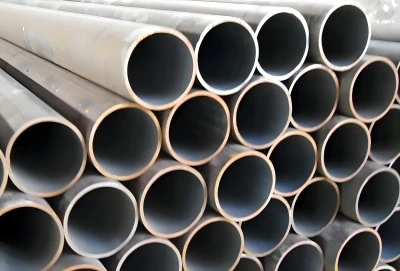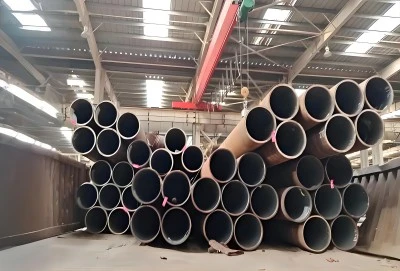ASTM A500 structural tubing is a crucial component in various construction and engineering projects. When it comes to choosing between Grade A and Grade B, understanding their differences is essential for making informed decisions. Grade B offers higher yield strength, making it superior for load-bearing applications, while Grade A is more suitable for lighter structures. This article delves into the key distinctions between these two grades, helping professionals in the oil and gas, water supply, and industrial manufacturing sectors select the right tubing for their specific needs.
|
|
|
Strength Comparison: Grade A vs Grade B
Yield Strength: Grade B's Advantage in Load-Bearing
The most significant difference between ASTM A500 Grade A and Grade B structural tubing lies in their yield strength. Grade B boasts a higher yield strength, typically ranging from 42,000 to 46,000 psi, compared to Grade A's 33,000 to 39,000 psi. This enhanced yield strength gives Grade B a distinct advantage in load-bearing applications, making it the preferred choice for heavy-duty structures and industrial projects.
For pipeline engineers and structural specialists working on offshore platforms or large-scale industrial facilities, this higher yield strength translates to improved structural integrity and safety margins. Grade B tubing can withstand greater loads before permanent deformation occurs, providing an extra layer of reliability in demanding environments.
Tensile Strength: Similarities Between A500 Grades
While yield strength varies significantly, the tensile strength of both Grade A and Grade B ASTM A500 structural tubing is relatively similar. Both grades typically have a minimum tensile strength of 45,000 psi. This similarity means that both grades can withstand similar maximum loads before failure, but Grade B's higher yield strength allows it to maintain its shape under higher stress levels.
For project procurement managers considering material selection, this similarity in tensile strength means that both grades can be suitable for applications where ultimate load capacity is the primary concern. However, the choice between Grade A and B often comes down to the specific stress requirements and safety factors of the project.
Impact on Structural Integrity in Construction Projects
The differences in strength properties between Grade A and Grade B ASTM A500 tubing have significant implications for structural integrity in construction projects. Grade B's higher yield strength allows for greater design flexibility and can result in more efficient use of materials. This is particularly valuable in bridge and building structures where weight reduction without compromising strength is often a key consideration.
For large-scale engineering contractors working on projects in regions like the Middle East or Southeast Asia, where environmental conditions can be harsh, the enhanced structural integrity offered by Grade B tubing can provide added assurance against unexpected loads or stresses. However, it's important to note that Grade A tubing remains a viable and cost-effective option for many applications where the higher yield strength of Grade B is not necessary.
Applications: When to Choose Grade A or B
Grade A: Ideal for Light to Medium-Duty StructuresASTM A500 Grade A structural tubing finds its niche in light to medium-duty applications. Its lower yield strength makes it a cost-effective choice for structures that don't require the higher load-bearing capacity of Grade B. Common applications for Grade A tubing include:
- Residential and light commercial construction
- Furniture and equipment frames
- Smaller-scale agricultural structures
- Temporary support structures in construction sites
For plant equipment managers overseeing facilities with less demanding structural requirements, Grade A tubing can offer an economical solution without compromising safety or performance. Its versatility and ease of fabrication make it a popular choice for a wide range of general-purpose applications.
Grade B: Preferred for Heavy-Duty Industrial Applications
ASTM A500 Grade B structural tubing is the go-to choice for heavy-duty industrial applications, particularly in sectors such as oil and gas, offshore construction, and large-scale manufacturing facilities. Its higher yield strength makes it ideal for:
- High-rise building frameworks
- Industrial plant support structures
- Bridge construction
- Heavy machinery frames
- Offshore platform structures
Pipeline and structural engineers working on projects like the MOBIL OIL AUSTRALIA project or similar large-scale endeavors in the Middle East and Southeast Asia often prefer Grade B tubing for its superior load-bearing capabilities and enhanced structural integrity.
Industry-Specific Use Cases: Oil & Gas vs. Construction
In the oil and gas industry, Grade B tubing is often the preferred choice due to its ability to withstand the extreme pressures and harsh environments typical of offshore platforms and onshore processing facilities. Its higher yield strength provides an additional safety margin critical in these high-risk environments.
Conversely, in the construction industry, the choice between Grade A and B often depends on the specific requirements of each project. High-rise buildings and large commercial structures typically utilize Grade B for primary load-bearing elements, while Grade A might be used for secondary or non-load-bearing components to optimize costs without compromising overall structural integrity.
Cost-Benefit Analysis of ASTM A500 Grades
Price Comparison: Grade A vs Grade B TubingWhen considering ASTM A500 structural tubing, the price difference between Grade A and Grade B is a crucial factor for project procurement managers. Generally, Grade B commands a higher price due to its superior yield strength and broader range of applications. The price differential can vary, but Grade B typically costs about 5-10% more than Grade A.
However, this price difference should be evaluated in the context of the entire project. For large-scale projects in the oil and gas sector or major construction endeavors, the additional cost of Grade B tubing may be negligible compared to the overall budget, especially when considering the potential long-term benefits and reduced risk.
Long-Term Value: Durability and Maintenance Considerations
While the initial cost is higher for Grade B tubing, its long-term value often justifies the investment. The increased durability and load-bearing capacity of Grade B can result in reduced maintenance needs and a longer service life, particularly in demanding industrial environments.
For projects in challenging locations, such as offshore platforms in Southeast Asia or industrial facilities in the Middle East, the enhanced durability of Grade B tubing can translate to significant savings in maintenance and replacement costs over the structure's lifetime. This aspect is particularly relevant for plant equipment managers who must consider the total cost of ownership rather than just the initial purchase price.
ROI: Balancing Initial Costs with Performance Benefits
Calculating the return on investment (ROI) for choosing Grade B over Grade A involves weighing the higher initial costs against the long-term performance benefits. In many cases, especially for heavy-duty applications, the ROI of Grade B tubing is superior due to:
- Reduced need for overdesign and material use
- Lower frequency of inspections and maintenance
- Extended service life of the structure
- Enhanced safety margins, potentially reducing liability risks
For large-scale engineering contractors working on global projects, the decision to use Grade B tubing can also impact project timelines and overall efficiency. The higher strength of Grade B may allow for faster construction times and simplified design processes, further enhancing its ROI.
The choice between ASTM A500 Grade A and Grade B structural tubing hinges on the specific requirements of each project. Grade B's superior yield strength makes it the preferred option for heavy-duty industrial applications, particularly in the oil and gas sector and large-scale construction projects. Grade A, while less robust, remains a cost-effective choice for lighter structures and non-critical components. When making a decision, professionals must consider factors such as load requirements, environmental conditions, long-term durability, and overall project economics. By carefully weighing these factors, engineers and project managers can ensure they select the most appropriate grade of ASTM A500 tubing for their specific needs, optimizing both performance and cost-effectiveness.
Where to Buy ASTM A500 Structural Tubing?
For high-quality ASTM A500 structural tubing that meets the demanding requirements of global industrial and construction projects, look no further than Hebei Longma Group. Our state-of-the-art production facilities, equipped with German-imported and independently developed equipment, ensure top-notch quality and consistency. With a professional team of over 300 employees, including 60+ technical experts, we guarantee expertise in every aspect of tubing production.
Our comprehensive testing facilities, including ultrasonic flaw detectors and industrial X-ray equipment, ensure that every piece of tubing meets the highest standards. We pride ourselves on fast delivery, with standard thickness steel pipes ready in as little as 7 days. Our products come with complete certifications, including API 5L, ISO 9001, ISO 14001, and more, meeting global quality standards.
At Hebei Longma Group, we offer competitive pricing without compromising on quality, thanks to our long-term partnerships with raw material suppliers and our integrated production model. For all your A500 structural tubing needs, contact us at info@longma-group.com.














